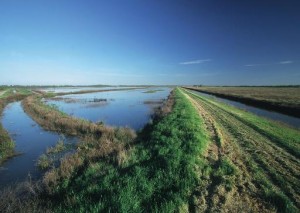
Landowners used the Natural Resources Conservation Service’s Wetlands Reserve Program to restore this wetland area. Photo by Gary Kramer
Scientists with USDA’s Natural Resources Conservation Service recognize the environmental and economic benefits regional wetlands provide and the importance of preserving wetland resources.
More than 220 million acres, or over 50 percent, of the nation’s wetlands no longer function, and some states lost over 90 percent of their wetland acres due to factors such as logging, construction and stream channeling.
In recent years, public education about the value and functions of wetlands and successful restorations are helping restore natural wetlands.
“The greatest potential for wetland restoration is on private lands,” said NRCS’ Acting Chief Jason Weller, since more than 70 percent of the nation’s land is privately owned. “Those are the people influencing our future landscapes.”
Wetlands — whether they’re called marshes, swamps, bogs or fens — are good for the environment but also have significant economic benefits.
For instance, plants and biological processes in the wetlands break down pollutants like fertilizers used in farming into less harmful substances. Filtered water then flows into nearby streams or sinks into underground aquifers, which become sources of municipal drinking water.
Towns are able to reduce water treatment system costs and are restoring wetland areas. As an added benefit, wetlands slow down and soak up water that runs off the land, reducing flood impacts and eliminating the need to build expensive flood control structures like dams.
NRCS helps private landowners bring back and preserve wetlands through the Wetlands Reserve Program, which is also improving habit and recreational opportunities.
When a landowner enrolls into WRP to restore and protect natural wetlands or enhance areas, they keep the recreation rights to the property. This means hunting, fishing, bird-watching and other activities can still be enjoyed and can offer economic benefits to nearby towns as well.
In 2011, 90.1 million U.S. residents 16 years and older, which is about 38 percent of the population, participated in wildlife-related recreational activities, according to the U.S. Fish and Wildlife Service. Nationwide, it is estimated that hunters spend about $145 billion on travel, equipment and other associated expenses, creating an economic engine fueled partly by healthy wetlands.
One Maryland landowner, Kirby Wells, created a wildlife haven and found a way to keep the 1,700 acre farm in the family. Restoration began in 2010 with a harvest of 205 acres of 20-year-old pine for wood chips. The single species of pines was replaced with a variety of native trees and shrubs that provide habitat for a wide diversity of species such as pileated woodpeckers, black and white warblers and wild turkey.
“Our purpose for this particular property is to use it for recreation purposes such as hunting and observation of non-game wildlife,” Wells said.
The return of these creatures is a welcome sight for the Wells family and is echoed throughout the nation.
“The popularity of WRP, the premier voluntary wetland restoration program on private lands, has been amazing,” said NRCS’ National WRP Manager, Randy Epperson.
“WRP began as a pilot in nine states to address pressing natural resource concerns in 1992. Since that time, more than 11,000 landowners have restored about 2.5 million acres of wetlands.”
People participate for different reasons, he said, but the bottom line is that many public benefits are provided by wetlands.
Michael Crowder, general manager on the 2,000-acre Barker Ranch in West Richland, Wash., and other wildlife-enthusiast shareholders also worked with NRCS to set up a series of WRP easements on the land.
The ranch annually donates a duck hunt to Camp Patriot, an organization for veterans. Now nearly eight miles of wetlands are restored and wounded or disabled military veterans who used to be sportsmen but thought they no longer had the same access to the great outdoors have the opportunity to rekindle that experience on Barker Ranch.
“It’s a lot of work—more hours than I would like sometimes. But the work is self-rewarding; you don’t have to have someone tell you you’ve done a good job when you pull up to a pond and see three different groups of wood duck broods,” Crowder said. “It’s neat to see them come back year after year.”
Migration, breeding, nesting and feeding habitat for millions of waterfowl and shorebirds as well as important winter cover for pheasants and other upland wildlife are just some additional benefits of wetlands. By preserving natural wetlands, the environment, communities and wildlife benefit.
Wetlands vary by region, soil type, climate, vegetation and water saturation levels and are home to thousands of different plant and animal species, many of which are threatened and endangered. Not all wetlands provide every benefit, but they all still provide an overarching benefit to the communities, environment and wildlife of the area.
NRCS offers financial and technical assistance to remove marginal land from agricultural production, restore it to a functioning wetland and protect it from future development.
To learn more about USDA’s Natural Resources Conservation Service (NRCS) and how to enroll in theWetlands Reserve Program (WRP) or contact the local service center.





